Black Mesa Golf Club
New Mexico, United States of America
Green Keeper: Pat Brockwell
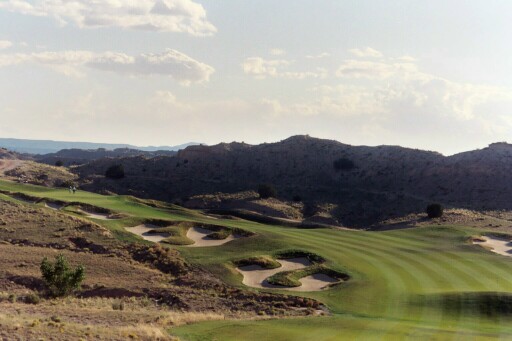
Truly an enchanting setting, Black Mesa is on the Santa Clara Pueblo thirty minutes north of Santa Fe. With the afternoon shadows growing, the golfer enjoys a game alone in nature.
There is much to be thankful for in modern architecture. Travel and money are such that courses are being built on remote properties that possess great natural golfing qualities. Sand Hills Golf Club was not practical fifty years ago. Irrigation and new grasses make course construction feasible in spots never thought possible. Cabo de Sol might be the finest piece of property upon which the Nicklaus organization will work.
Desert golf has become popular and its treeless environment open to the wind shares key elements with the game’s origins of links golf.Tom Doak’s Apache Stronghold, Gil Hanse’s Rustic Canyon and Coore & Crenshaw’s Talking Stick are perfect examples of classic architectural features being applied in a desert setting. Importantly, housing will never mar the golf at these three courses.
And in the spring of 2003, another sterling example opened in the New Mexico high desert. Once again an architect, in this case Baxter Spann of Houston-based Finger Dye Spann Golf Course Architects, has transposed an appreciation of classic architectural concepts upon the altogether unique and striking New Mexico landscape.
The result is a most welcome original. Incorporating natural landforms where possible into the design, Spann’s ideal routing weaves in and around sandstone rock formations and arroyos. With a local walking green fee of $40, the golfer is correct to assume that construction costs must have been reasonable and such can only be the case when the architect works with – as opposed to against – nature.
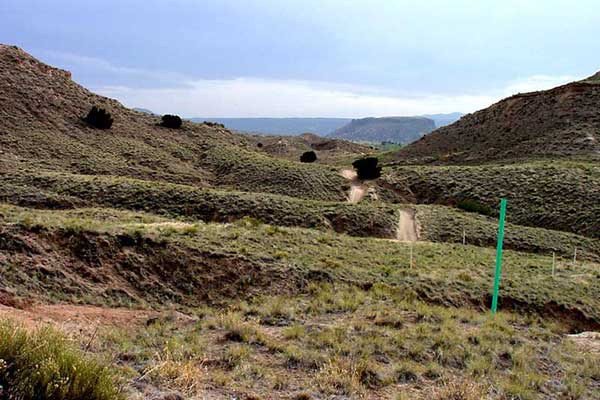
The cost to go from here to…
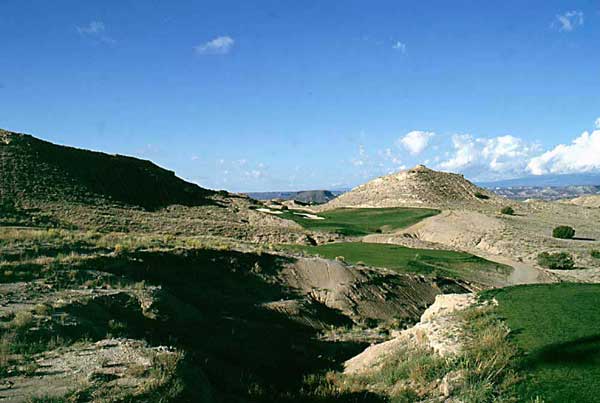
… here was reasonable.
What are specific examples of Spann applying tried and true architectural tenets upon this fresh landscape? A review of the holes shows plenty of examples.
Holes to Note
First hole, 385 yards; The tell-all moment at Black Mesa occurs straightaway on the first tee. In front of the golfer is scant view of a fairway but he is told there is one and his tee ball shall find it provided he hits over the shoulder of the hill. Spann appreciates that some will crucify him for having a forced carry to a blind fairway as the opening shot of the day yet he reasons the trade-off is worth it. There are only two gaps in a 1,600 yard long sandstone rock formation that bisects the property of the first nine. If he gets the golfer through this gap, a series of wonderful holes from the second through the fifth follow and he can return the golfer through the second gap at the eighth. Without doubt, Spann concluded this is the best routing. Now the question is what should he do about the first tee ball? Destroy the hillside with the heavy machinery at his disposal and provide the golfer with a perfect view of the fairway? Yet, why demolish a natural feature? The shot wouldn’t change; only the view. In the end, Spann leaves the hillside. Such a show of restraint is a welcome return to the core values held by the finest architects of the first half of the 20th century who built courses reflective of their environment.

The 1st fairway is over the two bunkers that Spann cut into the hillside. Only the last eighty yards of the hole can be seen as it sweeps up and to the left.
Second hole, 405 yards; One of the principles of classic design is to give the player room off the tee and tighten the challenge by the green complex. In this manner, more skill sets of players can enjoy the course. The second fairway is amply wide for a hole of this length and plays to an elevated green set in a saddle. To miss the green left or right is problematic thanks to the natural defenses of the terrain. Of great interest is the false front where a ball can be on the green one moment and twelve yards off the next. The green falls away behind as well and is not marred by mounds or back walls found on some of New Mexico’s noted courses.
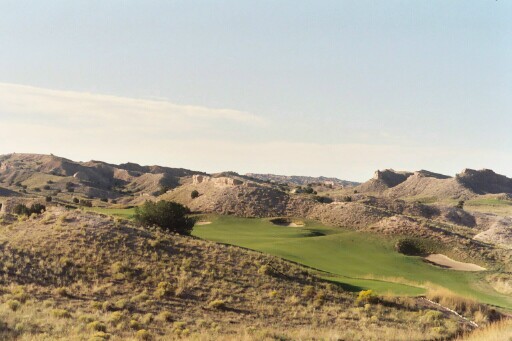
The 2nd green is to the left of juniper bush on the hill. Spann created a fine diagonal angle off the tee.

The 2nd green sheds balls that hit by the stand-up golf bag as the slope takes the ball left and well out of this picture. Note the ‘clean’ back drop to the green, which allows the golfer to soak in the natural beauty behind.
Third hole, 605 yards; The original routings didn’t venture the golfer into this portion of the property. Once it became clear the piece of property was indeed available, Spann jumped on it as it was rich with natural features. Eventually, today’s third, fourth and the back fifth tee were built. With a property as rugged as Black Mesa, the architect needs to balance finding challenging holes full of golf quality without overwhelming the player. Here at the third, a natural high spot fifty yards beyond the second green suggested itself for the tee and 560 yards further up, a gully made a fine natural defense for a green site. In part, the gully was ideal because at less than ten feet in depth, a recovery shot is possible (save for the occasional horrid lie) and Spann was conscious of ensuring that Black Mesa possessed plenty of short game interest/variety. Thus, the start and finish of the third hole seemed natural enough. However, slashing across in the 330-400 yard range from the tee was a large arroyo. Should Spann leave it as is? In this particular case, having a blind forced carry early in the round followed by another one over a gully seemed asking too much from the golfer. Thus, Spann eventually made the in-the-field decision to smooth over the arroyo and grass in much of it. The third remains a tough proposition requiring care on each of the three shots but at least most golfers will finish the hole with the same ball that they started!
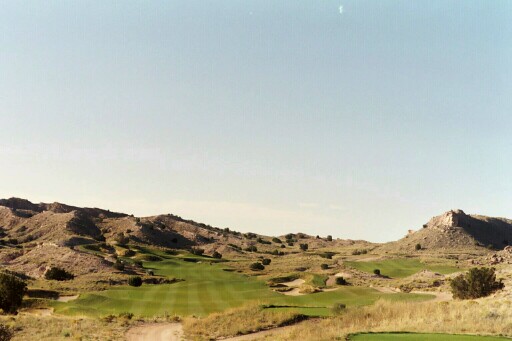
The long three shot 3rd leads the golfer well into exciting golf terrain.

A gully that fronts the 3rd green offers hope for recovery but it also puts pressure on executing the first two shots.
Fourth hole, 205 yards; Having found the third hole, the fourth became evident. Standing on a ridge to the left of the third green, Spann looked out 200 yards and saw a natural amphitheatre framed far right by a 30 foot deep bowl and left by a 20 foot tall knob. Though fill was required to create a green site with good golfing qualities between these two pronounced landforms, the hole looks entirely natural.
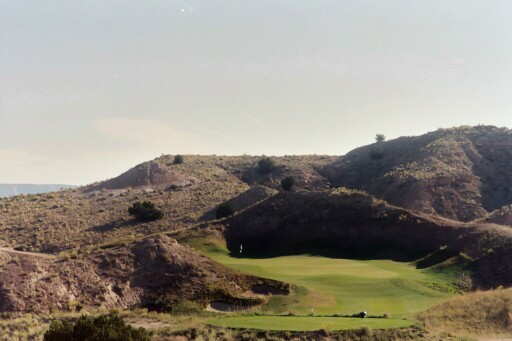
Tees further left leave the golfer with a view of just the right edge of the green – perhaps the 4th should be considered New Mexico’s version of the Lahinch’s Dell Hole!
Fifth hole, 495 yards; The best view that the golfer has from the elevated fifth tee is of the green nearly 500 yards away. Logically, the golfer likes to hit out directly toward the green and thus shorten his distance for his approach. And yet…that line requires a carry of over 270 yards to reach the fairway. Right of that and the carry grows to well over 320 yards. Ala some of the stakes found on links courses in the United Kingdom, a white flag on the near hillside indicates that the prudent line is well left ofthe view of the fifth green. Max Behr wrote often about the merits of a line of charm and of an architect tempting the player into doing something that he shouldn’t. The fifth is a fine example of a return to this concept within modern architecture.
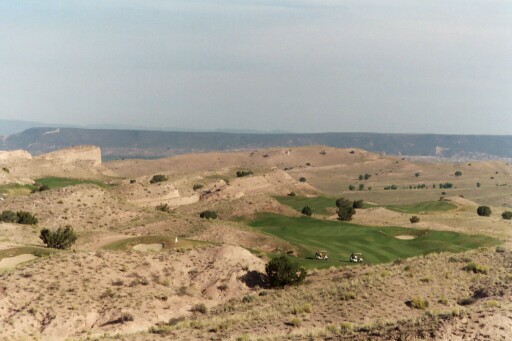
The 5th tee is 55 feet above the fairway and the distance from the white flag on the hillside in the near foreground to the formalized fairway bunkers on the left is 175 yards. A tee ball that drifts right of the green won’t find the fairway as the carry is prodigious. The 5th green is open in front, an important attribute for a hole this long.
Sixth hole, 565 yards; One of the benefits of rugged property is that slopes and landforms exist that kick balls in a variety of directions, an attribute in keeping with the origins of links golf. And one of the challenges of a round at Black Mesa is that level lies are tough to find, another feature sought by architects who like to distinguish the player from the range jockey. Shaped like a right parenthesis as such ), the 6th bends left around the side of a rock formation. The pitch of the fairway and green is thus from left to right. Can the golfer going for the green draw his tee ball against the left to right slope and shorten the way home? On the second shot, can the player not cut the ball too much with the ball below his feet? Several bunkers dot the way down the right of the fairway as one nears the green. The green itself is open front left and a skillfully played shot that comes in from the high left will bound onto the green from well back in the fairway. A course without ground game options is limiting; indeed, the author firmly believes that a course cannot be great without ground game options and Spann evidently is one of the few modern architects who appreciate this fact.
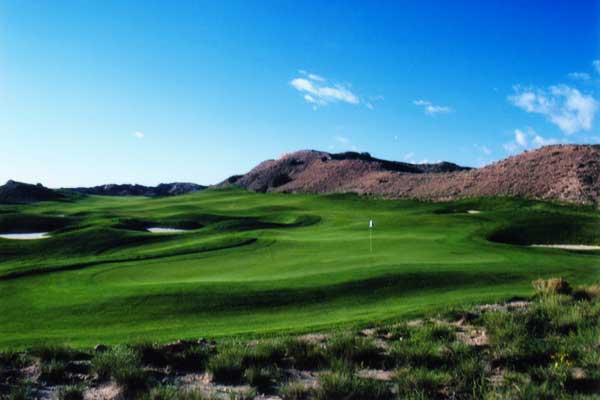
The ground game options are evident in this view from behind the 6th green complex.
Seventh hole, 355 yards; Some prefer a hole that is laid out before them with its (visible) hazards dictating a clear way to play the hole. For such people, modern courses built from the 1960s-1990s represent the height of architecture. Others view such holes as lacking in mystery as there is generally just one way to play them. Rather a hole like the twelfth at The Old Course at St. Andrews is well nigh perfect and far more alluring as there is no ‘right’ way to play the hole. Neither laying up off the tee or trying to drive the green is necessarily the ‘smart’ play and such maddening indecision can undermine even the best (remember Tom Watson’s quick pull off the twelfth tee in the last round of the 1984 Open?). And such it is with the seventh at Black Mesa which features a bunker directly between the tee and green. The curved back bank of this bunker kicks balls sharply ahead toward the green as well as to the right where two other bunkers lurk and left where a miserable angle greets the golfer. This hole takes getting to know, a laudable trait.
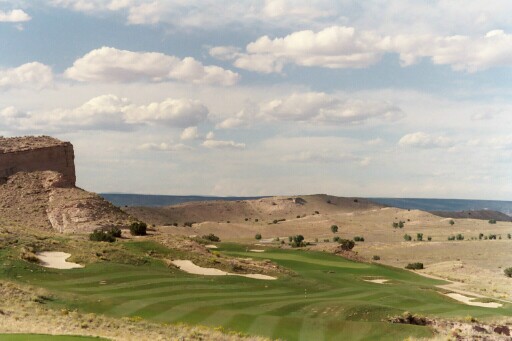
The bunker in the middle left of the picture is 100 yards shy of the front edge of the green. If the golfer can carry it, his ball might kick close to the angled green. Otherwise, should he lay back left, right or straightahead? Though the day’s hole location on the long diagonal three tier green with a seven foot (!) drop from high left to lower right will factor into the golfer’s decision, he may never settle on one answer, even after many rounds.
Eighth hole, 240 yards; From the seventh green, the golfer hikes up the hillside through a gap in the sandstone and from the crest of the hill, the long one shot eighth unfolds. Though well downhill, it requires a solid poke, especially when the prevailing wind blows up the canyon toward the golfer. Such lengthy one shotters are one of the few ways that an architect can make the tiger player hit long irons in this mile high plus altitude.
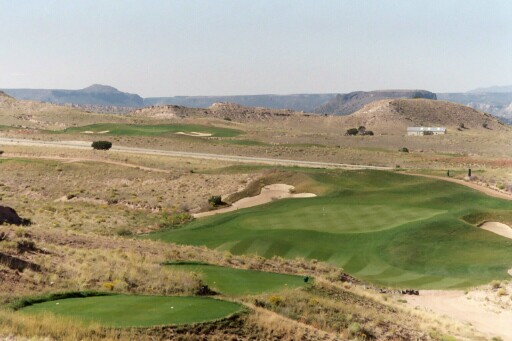
Spann leveled off several landforms to create the tees for the downhill 8th.
Ninth hole, 440 yards; Low profile features that hug the ground minimize the appearance of man altering nature. The bolder the man-made features, the more evident that the golfer is playing in a manufactured enviroment. After the ninth tee ball clears an arroyo, the remaining 250 yards of the hole are on the tamest part of theproperty. And as the course is already full of dramatic features, Spann did not want to overwhelm the golfer and wisely kept the bunkers and green at ground level.
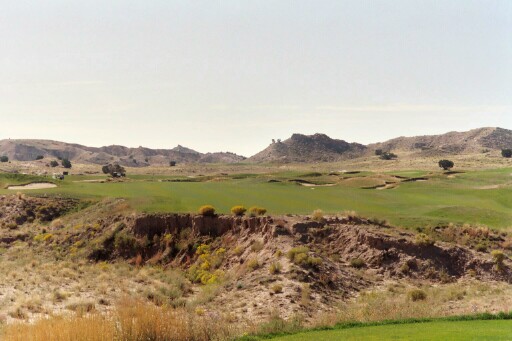
Once over the arroyo with one’s tee ball, the rest of the features on the 9th hole hug the ground.
Tenth hole, 455 yards; From the first time that he walked the property in the fall of 1998, Spann knew he would keep the tee ball between two rock forms to a natural saddle fairway as part of any final routing. The green slopes left to right and runs away from the player ala a reverse redan.
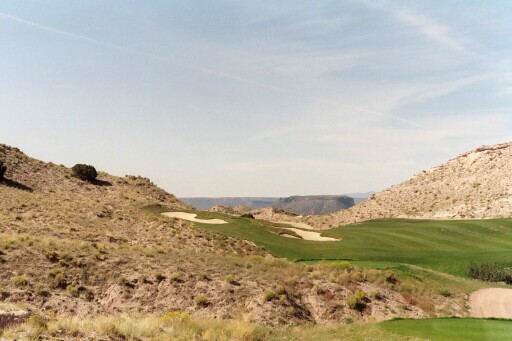
Options abound off the 10th tee on this dogleg left and range from a power hitter hitting a straight ball over the bush on the left hillside to a more conventional play of flying the bunkers on the inside of the dogleg to aiming right of them and playing a draw. Such options are almost non-existent on tree-lined courses.
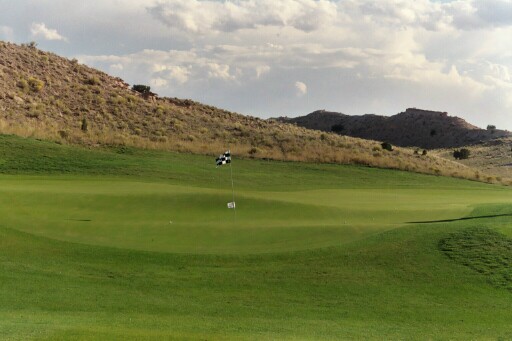
The 10th green, with its wicked front hole location. More times than not the hole is up top and the golfer can use the reverse redan features of the green to feed the ball toward the hole.
Eleventh hole, 170 yards; In an ideal routing, the architect takes the golfer to the most visually appealing parts of the property. In that manner, the golfer is made all the more aware of the beauty that surrounds him, surely a good thing.
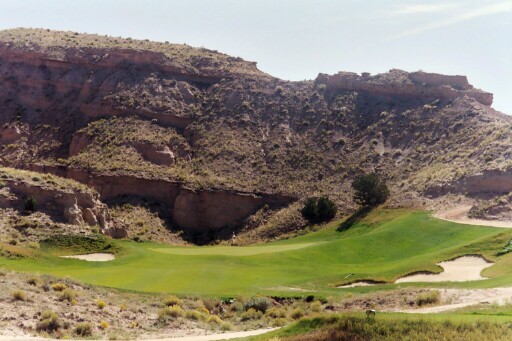
Spann did well to incorporate this stunning backdrop into the course. From the player’s perspective, the challenge is to stay below the hole on this sharply pitched green.
Twelfth hole, 405 yards; While beauty without strategy remains beautiful by definition, for the golfer, it becomes less engaging with time if there is nothing to accomplish. And a trademark of every classic course is that it beckons the golfer for a return game with strategy being crucial in luring the golfer back. And one of the most tried and true strategic elements is the diagonal carry whereby each golfer can pick his or her correct line based on ability and the day’s playing conditions. The first photograph in this course profile captures the angles that the each player has to consider off the 12th tee.

Looking down the 12th. Typical of the greens at Black Mesa, the 12th is well contoured and measures over 7,000 square feet. Also typical are the scale of bunkers – smallish bunkers would look hopelessly out of place in this expansive setting.
Thirteenth hole, 590 yards; Some properties have a homogeneous feel and are none the worse for it with prime examples being Walton Heath Old, Hidden Creek, Pinehurst No. 2 and Sand Hills. However, other properties are more diverse and the architect takes delight in introducing the golfer to such different parts. Prime examples include Cypress Point, Friar’s Head, The Creek Club and Cape Breton Highlands. In the case of Black Mesa, it belongs more with the later than the former and the thirteenth is a fine example of a graceful shift to a different look.
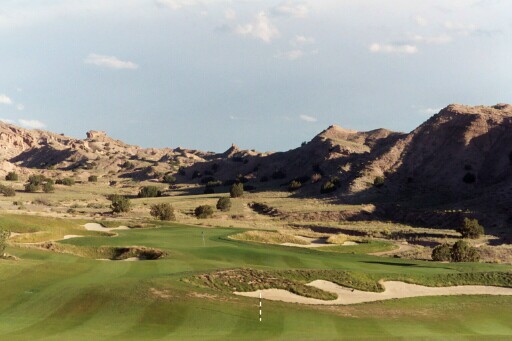
With 70 acres of field to the right of the 13th hole and beyond, the 13th enjoys a different feel from the rest of the course. Note the green, which is a full sixty paces deep and the back hole locations are a good five clubs different than the front ones.
Fourteenth hole, 340 yards; Central hazards area crucial tenet of good design. Hazards that lie between the golfer and the hole must be dealt with and thus lend holes strategic interest. A nice attribute of a central hazard can be that a golfer that successfully challenges it will get handsomely rewarded. As off the seventh tee, if the golfer can clear a central hazard in the right center of the fairway, his tee ball should land on the downslope of a knob and be propelled close and perhaps onto the putting surface. In the case of the sandy scrubby area in the fourteenth fairway, Spann actually shaved off a bit of the ridge to give the golfer a better view of the green, a scant 320 yards away. Spann’s hope is to goad the modern power player into having a go at the green as that’s when the fun begins given that the green may be the most severe on the course.
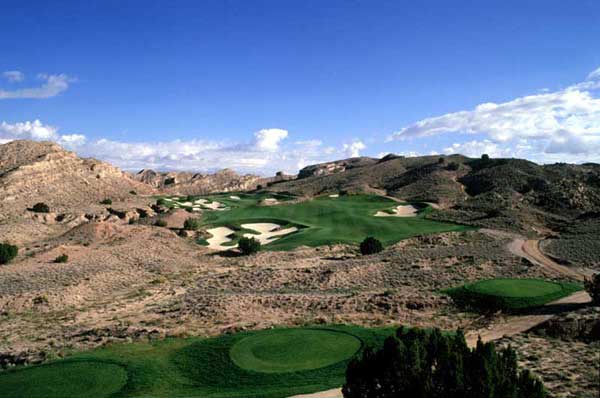
The large formalized bunker in the foreground is only a 165 yard carry from the blue tees; the real hazard is the knob further up. Spann built up the far right side of the fairway to give the player who lays up in that spot a good look down the angled green.
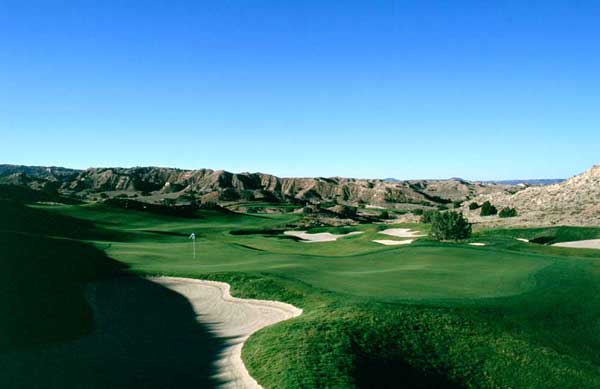
As seen from behind, the hourglass shaped 14th green may be the most severe on the course.
Fifteenth hole, 215 yards; The man-made water hazard twenty yards right of the green is the most modern feature and is out of context with the rest of the course. However, as with most one shotters, the green is the key. By now in the round, the first time golfer might be making some assumptions. Seeing the two hundred foot sandstone formation left and the general left to right flow of the land away from it, he can rightfully conclude that the green will follow nature’s lead and slope from left to right. In fact, a spine running toward the golfer further exacerbates the ground’s slope and creates a distinctive higher left and lower right side to the green. Yet, Spann is quick to point out that the contours function well together and a putt hit from the top left tier to the back of the green can find a cut in the spine and finish close to many of the back lower right hole locations.
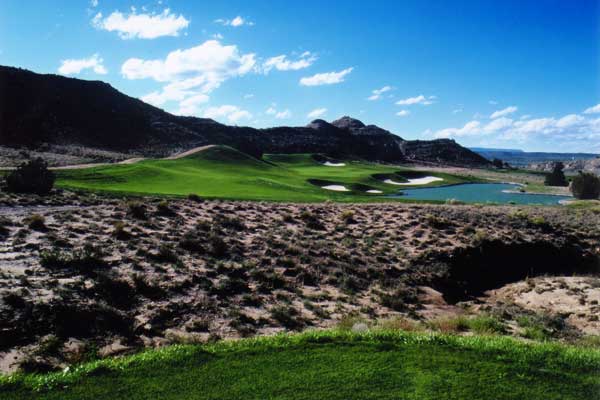
Everything slopes left to right at the 15th.
Sixteenth hole, 535 yards; Climbing up a relatively narrow canyon, the sixteenth was always going to be severe as the landform that it occupies narrows to less than twenty yards in two spots. A tough grueling two shotter could have been placed here but such a hole would have been unmerciful. Spann felt better served by keeping the hole within reach of the average player. Initially, he considered a short two shotter with a long one shotter to follow but the prior two were better such holes. In an effort to add variety, a reachable three shotter fit in well. If the golfer keeps his wits, he can progress up the fairway without undue trouble but the penalties are severe for the greedy golfer who forces the issue.
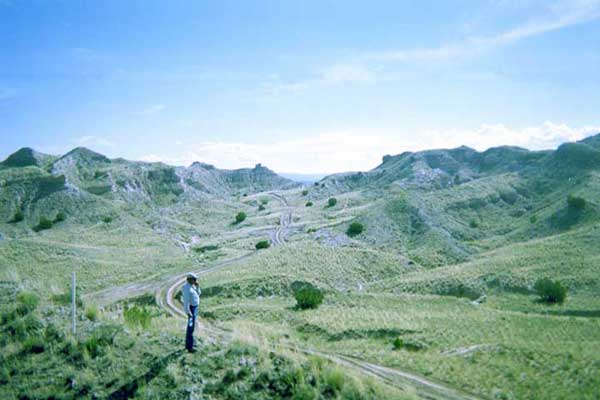
The 16th would eventually feed up this canyon.
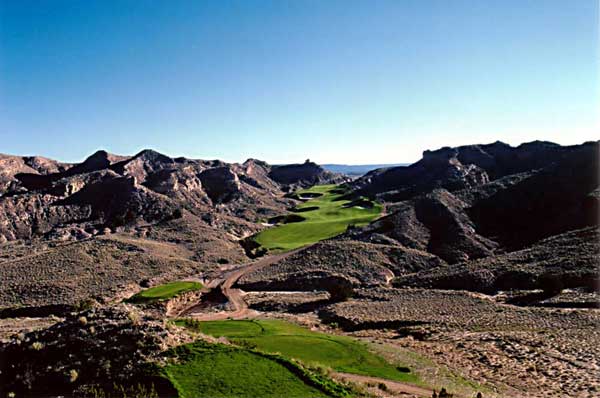
A golfer content with treating the 16th as a three shotter can fit his first two shots into the widest parts of the fairway.
Seventeenth hole, 425 yards; One of the shames of modern architecture is how man’s heavy hand wipes away the interesting random contours found in nature. Not so at the seventeenth where its lumpy-bumpy fairway reflects the initial property. Also, the skyline green is most attractive, with skyline greens in general having a storied place in golf architecture highlighted by the Eden hole at St. Andrews. With no framing or backdrop to comfort the golfer or aid in depth perception, the approach to such greens is particularly nervy.
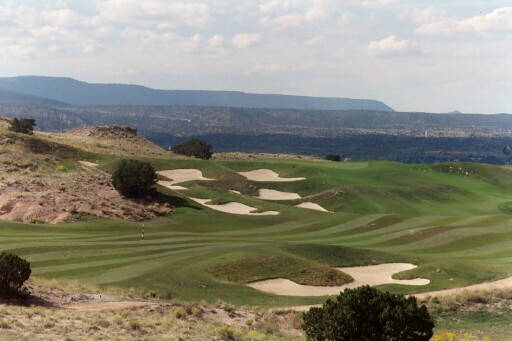
The bolder movements within the 17th fairway are evident even from several hundred yards away. Smaller knobs and hollows are encountered as one plays the hole.
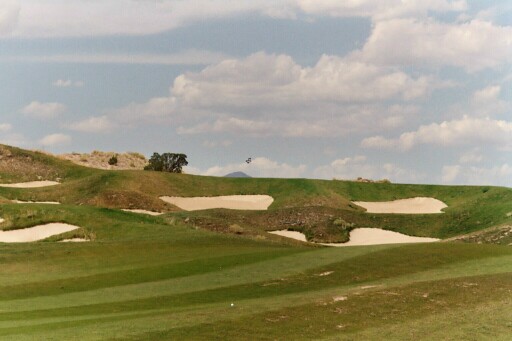
The horizon green makes the approach to the 17th green one of the most appealing on the course. The green is only twenty yards deep over the greenside bunkers. The green does balloon to the right so that this public access course can provide plenty of accessible hole locations.
Eighteenth hole, 430 yards; As at the second, fifth and twelfth, another appealing diagonal carry greets the golfer from the back markers on the Home hole. Further ahead, the green contours are virtually as Spann found them when he first walked the property. The construction team of Ortiz Earthscapes carefully preserved these interior contours and the Home green caps off a diverse set of eighteen greens rich with character. The architect could have easily had eighteen mundane putting surfaces, figuring that the golfer would hardly notice given the stunning scenery. Yet, given that greens are the ultimate target, to do so undermines the lasting appeal of any course. In fact, so good are the greens at Black Mesa, they deserve equal billing with the routing as the star of the design.
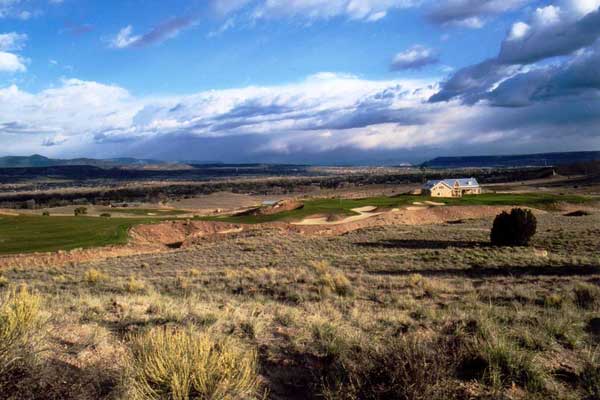
The 18th fairway starts left of this picture and runs downhill toward the clubhouse. The diagonal carry and the hole itself was included in each and every routing that Spann did.
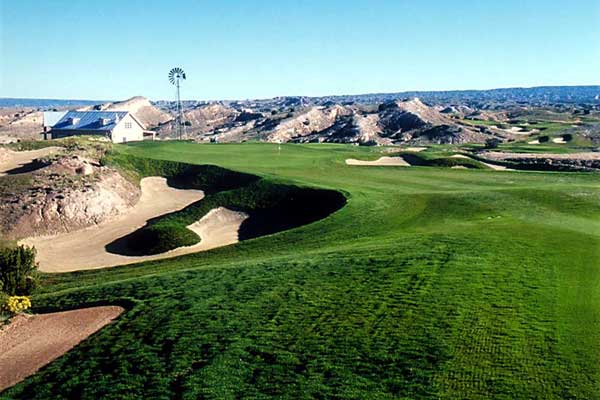
The 18th green complex features the deepest greenside bunkers on the course. Note the random contours within the green.
What conclusions can be drawn from a review of the eighteen holes at Black Mesa? Certainly, one is that classic architectural features abound with the twist being the stunning New Mexico setting and the unique landforms. As Spann modestly notes,
A site like that has a way of making everyone look good. But I can say this, in hindsight, I would not have wanted to touch that property without having had that 25 years experience under my belt already. I think it really is true that you have to ‘pay your dues’ in this profession – at least it is for me. You have to make a lot of mistakes to learn this art, but your mistakes are not on a canvas that you can wad up and throw away if it doesn’t come out right. And this land was too precious to make any blunders with – hopefully we did right by it.
Get it right he did and this form of high quality, affordable golf is a very exciting development for golf in New Mexico and indeed for the game in general. Additional such opportunities must surely exist in such states as Colorado, Arizona, New Mexico and Nevada. One can only hope that Baxter Spann gets many more opportunities to work on such projects – his approach of working with the land leaves the ownership a cost effective end product and the golfer will delight in trying to solve the strategic challenges for decades to come.
Though a heavily tree-lined Oak Hill might epitomize ‘championship’ golf as it held the pros in check during the 2003 PGA Championship, such style golf is well removed from golf’s origins where trees played no role. The links courses obviously didn’t possess trees nor did the heath courses. And neither do desert courses like Black Mesa.
As the game crossed the Atlantic, men like Leeds at Myopia Hunt, Fownes at Oakmont, Macdonald at both National Golf Club of America and Chicago Golf Club, Emmit/Travis at Garden City Golf Club and Wilson at Merion had trees completely removed or at the very least kept well back from play. Trees reduce playing angles by narrowing the playing corridors, provide definition, and block the wind – all three characteristics of no appeal to these architects.
Indeed, the world’s first great courses like Fowler’s Walton Heath in England and Macdonald’s National Links were open and expansive. The Old Course at St. Andrews that is considered a strategic marvel to this day didn’t become so until Old Tom Morris markedly widened its fairways. Such courses marked a sharp departure from the cramped, symmetric designs of the 1880s and 1890s.
Yet, as golf in the United States progressed inland in the first decade of the 20th century, many heretobefore features that were considered crucial for an ideal course were lost: wind became less of a factor; as clay replaced sandy soil, the need for built-up green complexes for drainage arose with an unintended result being that the aerial game took hold; the natural landforms became less pronounced and unique; and finally over time, green committees planted hundreds upon hundreds of trees with the negative effects as already mentioned above.
In an ironic twist, in the southwest part of theUnited States where the great past master architects never had the genuine opportunity to work, several modern day architects are working with properties that reverse some of the above. This is indeed an exciting time for modern architecture, as a tour around Baxter Spann’s work at Black Mesa exemplifies.

Though this may not look like landscape associated with traditional golf, Black Mesa assuredly possesses numerous traditional design attributes.
The End





![The Park, West Palm (Lit 9) [2023]](https://golfclubatlas.com/wp-content/uploads/2024/12/IMG_7092-2-scaled-500x383.jpg)


